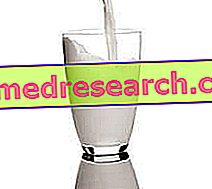Definition
Contrary to leukocytosis, leukopenia identifies a clinical condition in which the proportion of white blood cells falls below the normal range; in other words, leukopenia outlines an abnormal reduction in leukocytes in the blood.
The leukopenia differs based on the type of cells involved: we recall, in fact, that the white blood cells are classified in neutrophils, basophils and eosinophils.
- Leukopenia → number of white blood cells <3500 units / microlitre of blood
- Neutropenia → n ° of neutrophils <500-1500 units / microlitre of blood
- Eosinophilopenia → n ° of eosinophils <40 units / microliter of blood
- Basophilopenia → number of basophils <10 units / microlitre of blood
Causes
Often, leukopenia is an immediate response of the organism to bacterial insults or acute inflammatory processes; however, the reduction of leukocytes can result in: megaloblastic anemia, rheumatoid arthritis, vitamin B9 deficiency, copper and zinc, dengue, hepatitis B, antibiotic drugs, diuretics, steroids, immunosuppressants, immunodeficiency, hyperthyroidism, leukemia, lupus, malaria, radiation, sarcoidosis, sepsis, tuberculosis.
Symptoms
Neutropenia is the most common form of leukopenia, and is characterized by symptoms such as oral ulcers, pharyngitis, fever, pain, recurrent infections (especially staphylococci), swollen lymph nodes, sepsis, stomatitis. The vast majority of patients with leukopenia have, in general, a high risk of contracting serious infections.
Information on Leukopenia - Drugs for the Treatment of Leukopenia is not intended to replace the direct relationship between health professional and patient. Always consult your doctor and / or specialist before taking Leucopenia - Drugs for the Treatment of Leukopenia.
drugs
Since leukopenia exaggeratedly increases the risk of bacterial and viral infections, patients who record an alteration of the leukocyte count, even if sensitive, should pay particular attention to the primary prevention of infectious diseases, periodically undergoing specific vaccinations. All patients suffering from leukopenia should also take care of their personal hygiene and hands, wear a mask to protect themselves from pathogenic insults and do not approach patients.
The medical-pharmacological therapy is subordinated to the triggering etiopathological element; for example, in some cases, the plasmatic reduction of leukocytes is compromised by the administration of powerful drugs; it can be deduced that the suspension of the drug and its replacement by a medicine with a similar activity reduces the symptoms, bringing the leukocyte count back to normal.
Generally speaking, a simultaneous bacterial infection is observed in patients suffering from leukopenia: for this reason, the administration of antibiotics is one of the most effective therapies for warding off collateral symptoms. Only in cases of extreme gravity, it is necessary to intervene with drugs to stimulate the synthesis of white blood cells and the administration of immunoglobulins (antibodies) derived from blood transfusions.
If the cause of leukopenia depended on a tumor or leukemia, the patient will have to follow one or more chemotherapy cycles.
Antibiotic drugs for the treatment of infections in the context of leukopenia
In the context of leukopenia, the intake of broad-spectrum antibiotics in patients with high fever is essential; often it is preferable to administer these drugs intravenously even before identifying the specific pathogen. If the alteration of the body temperature persists after the first 72 hours from the beginning of the antibiotic therapy, in all probability, the leukopenia does NOT depend on bacterial infections; therefore, the patient must undergo further diagnostic tests.
The following are the most important antibiotic medications and first line medicinal products. The dosage cannot, however, be reported: it is up to the doctor to decide the optimal dosage for that patient, based on the causative causative agent; similar speech for the duration of the therapy.
- Vancomycin (eg Zengac, Levovanox, Maxivanil), glycopeptide class
- Amphotericin B (eg Abelcet), a polyene drug indicated for the treatment of fungal infections in the context of leukopenia
- Acyclovir (eg Aciclovir, Xerese, Zovirax): indicated for the treatment of leukopenia in the context of varicella or infections sustained by the Herpes simplex virus
- Piperacillin (eg Limerik, Picillin, Ecosette): the drug is a semi-synthetic penicillin, with a broad spectrum of action, indicated for bacterial infections in the context of leukopenia
- Trimethoprim-sulfamethoxazole (eg Bactrim), sulfonamide antibiotic. The drug should be considered in therapy for the prevention of pneumonia in leukopenic patients who DO NOT have fever. The drug appears to reduce the frequency of bacterial infections.
Drugs to reduce secondary symptoms of leukopenia
Oral ulcers and oropharyngeal ulcers are very common in patients with leukopenia. To relieve discomfort, it is advisable to take local anesthetic drugs, topical corticosteroids and specific gargles. Here are some examples:
- Benzocaine (eg. Foille)
- Benzidamine (eg Difflan)
- Chlorhexidine (eg. Disinfene cream, Golasan mouthwash)
- Nystatin (eg Mycostatin) for Candida albicans coinfection in the oral cavity, even in patients with leukopenia
For further information and dosage: read the article on drugs for the treatment of oral ulcers
Drugs to balance the concentration of white blood cells in the blood
The administration of the drugs described below is indicated to treat the most common form of leukopenia (neutropenia), both in the chemotherapy-dependent variant and in that associated with HIV infections.
- Filgrastim (eg Zarzio, Tevagastrim, Filgrastim Hexal, Biograstim, Nivestim): for the treatment of the neutrophilic variant of leukopenia associated with chemotherapy treatments, it is recommended to start therapy with a drug dose of 5 mcg / kg, subcutaneously or intravenous, once a day, for max. 2 weeks (up to a neutrophil count of 10, 000 units / microlitre of blood). Administer after 24 hours from chemotherapy therapy. If necessary, increase the dose by 5 mcg / kg per day in case of no response after 5-7 days. For the treatment of leukopenia (var. Neutrophilia) associated with AIDS, it is recommended to take the drug at a dose of 1-5 mcg / kg subcutaneously or intravenously, once a day. If no improvement is observed after 5-7 days, increase the dose by another 5 mcg / kg.
- Pegfilgrastim (eg. Neulasta): the drug is used in therapy to reduce the duration of neutropenia and the incidence of its febrile variant. The drug is available in syringes and in pre-filled pens (each dose consists of 6 mg of drug): administer the drug subcutaneously. Consult your doctor for more information.
Corticosteroid drugs : indicated for the treatment of leukopenia in patients with evident increase in cell turnover, expression of autoimmune diseases.
- Prednisone (eg Deltacortene, Lodotra): administered at a dose of 0.5-1 mg / kg per day (every other day), this drug appears to improve the white blood cell count (especially neutrophils) in patients with leukopenia.



